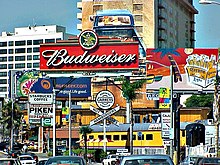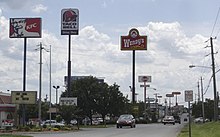 A billboard (sometimes also called a hoarding in the UK and many other parts of the world) is a large outdoor advertising structure (a billing board), typically found in high traffic areas such as alongside busy roads. Billboards present large advertisements
to passing pedestrians and drivers. Typically showing large, ostensibly
witty slogans, and distinctive visuals, billboards are highly visible
in the top designated market areas. Bulletins are the largest, most
impactful
standard-size billboards. Located primarily on major highways,
expressways or principal arterials, they command high-density consumer
exposure (mostly to vehicular traffic). Bulletins afford greatest
visibility due not only to their size, but because they allow creative
"customizing" through extensions and embellishments.
A billboard (sometimes also called a hoarding in the UK and many other parts of the world) is a large outdoor advertising structure (a billing board), typically found in high traffic areas such as alongside busy roads. Billboards present large advertisements
to passing pedestrians and drivers. Typically showing large, ostensibly
witty slogans, and distinctive visuals, billboards are highly visible
in the top designated market areas. Bulletins are the largest, most
impactful
standard-size billboards. Located primarily on major highways,
expressways or principal arterials, they command high-density consumer
exposure (mostly to vehicular traffic). Bulletins afford greatest
visibility due not only to their size, but because they allow creative
"customizing" through extensions and embellishments.Posters are the other common form of billboard advertising, located chiefly in commercial and industrial areas on primary and secondary arterial roads. Posters are a smaller format than bulletins and are viewed principally by residents and commuter traffic, with some pedestrian exposure.
Painted Billboard
 Almost all these billboards were painted in large studios. The image was
projected on the series of paper panels that made up the billboard.
Line drawings were done, then traced with a pounce wheel that created
perforated lines. The patterns were then "pounced" onto the board with a
chalk filled pounce bag, marking the outlines of the figures or
objects. Then, using oil paints, the artists would actually use large
brushes to paint the image. Once the panels were installed using large
hydraulic booms on trucks, the artists would go up on the installed
billboard and touch up the edges between the panels. These large,
painted billboards were especially popular in Los Angeles where historic
firms such as Foster & Kleiser and Pacific Outdoor Advertising
dominated the industry. Eventually, these painted billboards gave way to
graphic reproduction, but hand-painted billboards are still in use in
some areas where only a single board or two is required. The "Sunset Strip"
in Los Angeles is one area where hand-painted billboards can still be
found, usually to advertise upcoming films or albums in the heart of the
entertainment industry.
Almost all these billboards were painted in large studios. The image was
projected on the series of paper panels that made up the billboard.
Line drawings were done, then traced with a pounce wheel that created
perforated lines. The patterns were then "pounced" onto the board with a
chalk filled pounce bag, marking the outlines of the figures or
objects. Then, using oil paints, the artists would actually use large
brushes to paint the image. Once the panels were installed using large
hydraulic booms on trucks, the artists would go up on the installed
billboard and touch up the edges between the panels. These large,
painted billboards were especially popular in Los Angeles where historic
firms such as Foster & Kleiser and Pacific Outdoor Advertising
dominated the industry. Eventually, these painted billboards gave way to
graphic reproduction, but hand-painted billboards are still in use in
some areas where only a single board or two is required. The "Sunset Strip"
in Los Angeles is one area where hand-painted billboards can still be
found, usually to advertise upcoming films or albums in the heart of the
entertainment industry.Advertising Style
 Billboard advertisements are designed to catch a person's attention
and create a memorable impression very quickly, leaving the reader
thinking about the advertisement after they have driven past it. They
have to be readable in a very short time because they are usually read
while being passed at high speeds. Thus there are usually only a few
words, in large print, and a humorous or arresting image in brilliant
color.
Billboard advertisements are designed to catch a person's attention
and create a memorable impression very quickly, leaving the reader
thinking about the advertisement after they have driven past it. They
have to be readable in a very short time because they are usually read
while being passed at high speeds. Thus there are usually only a few
words, in large print, and a humorous or arresting image in brilliant
color.Some billboard designs spill outside the actual space given to them by the billboard, with parts of figures hanging off the billboard edges or jutting out of the billboard in three dimensions. An example in the United States around the turn of the 21st century were the billboards (a chicken sandwich fast food chain), which had three-dimensional cow figures in the act of painting the billboards with misspelled anti-beef slogans such as "frendz don't let frendz eat beef." George Stonbely created the famous Time Square billboards. Including one on one times square.
The first "scented billboard," an outdoor sign emitting the odors of black pepper and charcoal to suggest a grilled steak, was erected on NC 150 near Mooresville, North Carolina by the Bloom grocery chain. The sign depicted a giant cube of beef being pierced by a large fork that extended to the ground. The scents were emitted between 7–10 a.m. and 4– to 7 pm from 28 May 2010 through 18 June 2010
Digital Billboards
 A digital billboard
is a billboard that is created from computer programs and software.
Digital billboards can be designed to display running text, display
several different displays from the same company, and even exist to
provide several companies a certain slot of time during the day. Because
of the versatility and increased potential revenue for these signs,
they are likely to become the standard for the future.
A digital billboard
is a billboard that is created from computer programs and software.
Digital billboards can be designed to display running text, display
several different displays from the same company, and even exist to
provide several companies a certain slot of time during the day. Because
of the versatility and increased potential revenue for these signs,
they are likely to become the standard for the future.Some companies that create the intelligence behind digital billboards are Four Winds Interactive, Scala and Helius.
Mobile Billboards
 Outdoor Advertising, such as a Mobile Billboard, is effective because
it’s hard to ignore. According to a UK national survey, it’s also
memorable. Capitol Communications Group found that 81.7 percent of those
polled recalled images they saw on a moving multi-image sign. This is
compared to a 19 percent retention rate for static signs.
Outdoor Advertising, such as a Mobile Billboard, is effective because
it’s hard to ignore. According to a UK national survey, it’s also
memorable. Capitol Communications Group found that 81.7 percent of those
polled recalled images they saw on a moving multi-image sign. This is
compared to a 19 percent retention rate for static signs.Unlike a typical billboard, mobile billboards are able to go directly to their target audience. They can be placed wherever there is heavy foot traffic due to an event – including convention centers, train stations, airports and sports arenas. They can repeat routes, ensuring that an advertiser’s message is not only noticed, but that information is retained through repetition.
Infitable Billboards
 An inflatable billboard is an inflatable framework with an attached
banner ad. Most of them famously appear near sports events or
exhibitions. Inflatable billboards can be installed nearly everywhere
standing free. They are secured with counter weights and tensioning
ropes.
An inflatable billboard is an inflatable framework with an attached
banner ad. Most of them famously appear near sports events or
exhibitions. Inflatable billboards can be installed nearly everywhere
standing free. They are secured with counter weights and tensioning
ropes.Multi-Purpose Billboards
 Some billboards are not used only for advertising ends; they can be
multi-purpose, meaning that they can have more than one function. So, an
advertising sign can integrate its main purpose with telecommunications
antenna and/or public lighting support. Usually the structure has a
steel pole with a coupling flange on the above-fitted advertising
billboard structure that can contain telecommunications antennas. The
lighting power supply cables and any possible antennas are placed inside
of the structure and fastened on appropriate steel wires.
Some billboards are not used only for advertising ends; they can be
multi-purpose, meaning that they can have more than one function. So, an
advertising sign can integrate its main purpose with telecommunications
antenna and/or public lighting support. Usually the structure has a
steel pole with a coupling flange on the above-fitted advertising
billboard structure that can contain telecommunications antennas. The
lighting power supply cables and any possible antennas are placed inside
of the structure and fastened on appropriate steel wires.Other Types of Billboards
 Other types of billboards include the billboard bicycle,
which is a billboard attached to the back of a bicycle or the largest
mobile billboard, a special advertising trailer to hoist big banners.
Mechanical billboards are billboards that display three different
billboards at different times, because the three advertisements are
attached to a conveyor that rolls around inside the billboard. There is
also such thing as a three-dimensional billboard, such as the ones at Piccadilly Circus, London, although this type of billboard is arguably mistaken for a simple advertising sign.
Other types of billboards include the billboard bicycle,
which is a billboard attached to the back of a bicycle or the largest
mobile billboard, a special advertising trailer to hoist big banners.
Mechanical billboards are billboards that display three different
billboards at different times, because the three advertisements are
attached to a conveyor that rolls around inside the billboard. There is
also such thing as a three-dimensional billboard, such as the ones at Piccadilly Circus, London, although this type of billboard is arguably mistaken for a simple advertising sign.Highway

Non-Commercial Use
 Not all billboards are used for advertising products and service- non profit group and government agencies
use them to communicate with the public. In 1999 an anonymous person
created the God Speaks billboard campaign in Florida "to get people
thinking about God", with witty statements signed by God. "Don't make me
come down there", "We need to talk" and "Tell the children that I love
them" were parts of the campaign, which was picked up by the Outdoor Advertising Association of America and continues today on billboards across the country.
Not all billboards are used for advertising products and service- non profit group and government agencies
use them to communicate with the public. In 1999 an anonymous person
created the God Speaks billboard campaign in Florida "to get people
thinking about God", with witty statements signed by God. "Don't make me
come down there", "We need to talk" and "Tell the children that I love
them" were parts of the campaign, which was picked up by the Outdoor Advertising Association of America and continues today on billboards across the country.South of Olympia, Washington is the privately owned Uncle Sam billboard. It features conservative, sometimes inflammatory messages, changed on a regular basis. Chehalis farmer Al Hamilton first started the board during the Johnson era, when the government was trying to make him remove his billboards along Interstate 5. He had erected the signs after he lost a legal battle to prevent the building of the freeway across his land. Numerous legal and illegal attempts to remove the Uncle Sam billboard have failed, and it is now in its third location.One message, attacking a nearby liberal arts college, was photographed, made into a postcard and is sold in the College Bookstore.
**Signboard Advertising**
Tidak ada komentar:
Komentar baru tidak diizinkan.